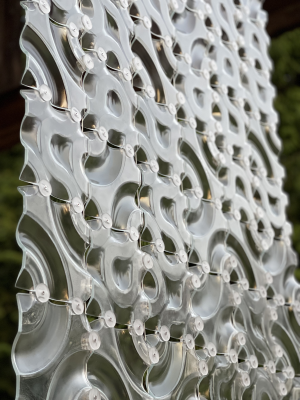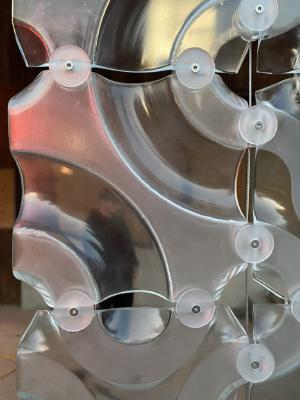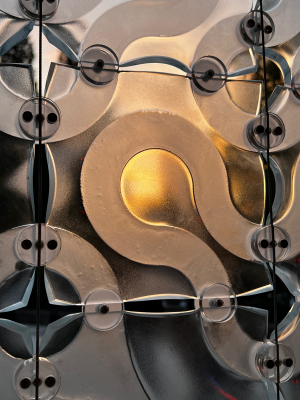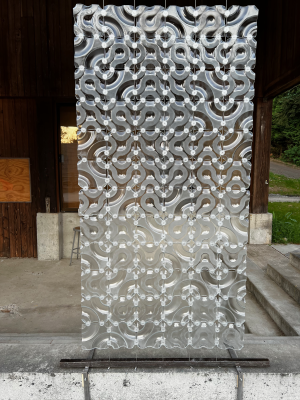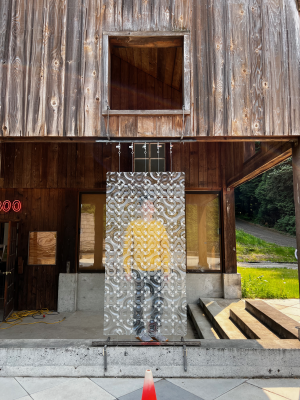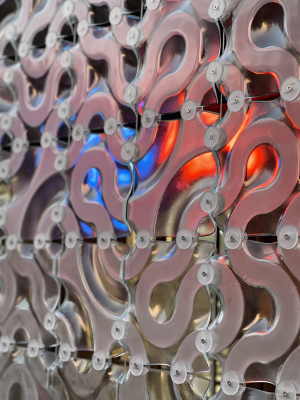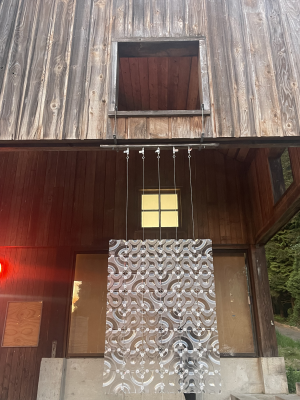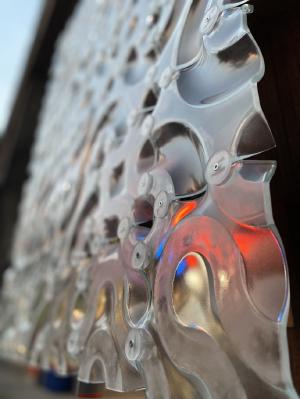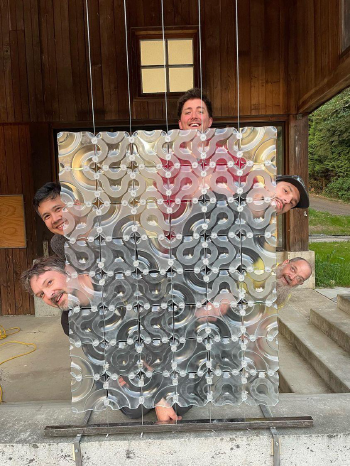
Showing Now!
Vetri is excited to announce Innovative Disruption, an exhibition featuring artists who defy conventional perceptions of glass by pushing boundaries and challenging norms. The artists in this show reflect the evolving landscape of glassmaking and highlight the transformative impact of new technologies on the craft. Artists featured in this exhibition are F5 Collective, Joe Hobbs, Anna Mlasowsky, and Hoseok Youn.
Opening Reception:
Thursday, August 3rd, from 5–8 pm Vetri: 1404 1st Ave, Seattle, WA 98101
#vetri #vetriglass #seattle #pilchuck #haubergfellowship #vitreluxe #f5collective #glassnow
About
In May 2023 as a member of the F5 Collective, I was awarded the John H. Hauberg fellowship at the Pilchuck Glass School in Stanwood, WA. The five of us spent 11 days in the woods creating, experimenting, playing, and enjoying time together. We’ve been fascinated with digital fabrication, computational design, tiling, and glass for the last four years. In our application to Pilchuck, we stated:
“By using the flexibility and precision of these tools combined with our traditional knowledge of processes and materials, we will create architectural scale work from tileable, interchangeable, customizable glass modules. The Hauberg Fellowship is a perfect opportunity for us to realize this goal, and we are excited about working in the mold shop, kiln studio, print shop, bot lab, and cold shop to do so.”
The Work
Here are several photos of the finished work. Read more below for details on how we designed and built it.
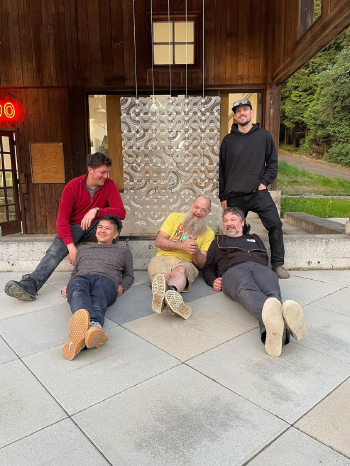
The People
F5 Collective is Nathan Sambar, Lynn Everett Read, Phirak Suon, Brandyn Callahan, and Brian Gillespie.
Our fellowship was supported by Pilchuck Glass School (including studio access, housing, food, materials, stipends, staff, beautiful environment, amazing people, and more), our employers for giving us time off, our families for letting us sneak away for so long, OMAX Corporation for donating some waterjet cutting, and Goldray Glass for a generous donation of float glass.
Planning
As a team, we met for months prior to the fellowship. We knew from the outset that we wanted to do a project as a group. We set deadlines for ourselves, had individual design projects, met, discussed, and voted on what path to take. We chose drop molding as the forming process, because it gave us variability not only in the molds themselves, but also variability in the formed glass based on process time and temperature - the longer and hotter we held the glass, the more it was going to move. Originally, we thought we’d use Phirak and Brandyn’s clay 3D printer to make the drop molds. But during one of our late-stage planning meetings, Brandyn wondered if we should waterjet cut some kiln shelves “just in case”. It turned out those kiln shelf molds were the center of the project. We just needed to figure out what pattern to use.
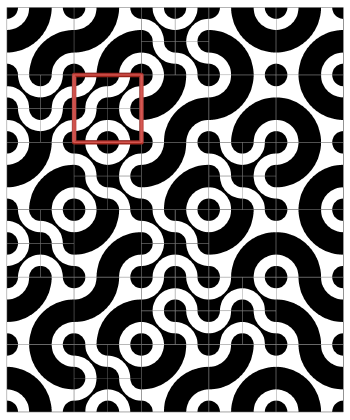
Pattern Language
We became fascinated with Truchet tiles several years ago. The inital tiling strategy was based on the Cyril Stanley Smith’s quarter-circle tiling:

When randomly rotated and tiled, it results in patterns like this:

We found that we could invert the colors, alter the scale and position of the tiles and end up with an even more interesting set of patterns. We selected three permutations of the half-scale patterns, as well as the full-scale pattern, a couple weeks before the residency.
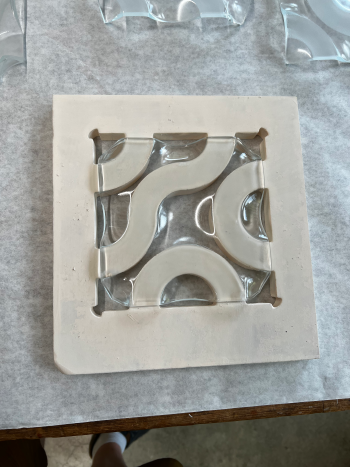
The final decision: are we slumping the black or white region? Slumping the white region would mean less fasteners (one at each corner vs two on a side), but would result in perhaps less interesting movement. We chose to slump the black regions, meaning the corners would move.
OMAX Waterjet Corp cut 12 molds out of mullite kiln shelf for us. This mold is outlined in red in the photo above.
The Residency
We landed at the Pilchuck Glass School on May 9, 2023. Five guys at one of the best glass facilities in the world, and a project to do. Nate, Brandyn, and Lynn focused early on kiln tests so we could dial in a firing schedule. Our goal was architectural scale, and I wanted to figure out how to make that happen.
12 kiln shelf molds means 12 tiles per firing. One firing per day. 10 days before assembly. With no mistakes, we could make 120 tiles. That’s a 5’ x 6’ wall. Woah.
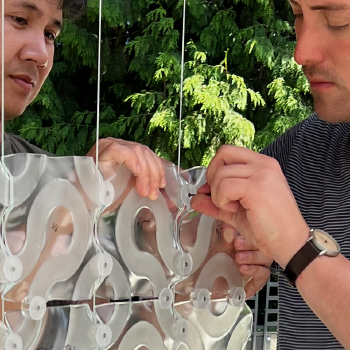
Holding it Together
Because we decided to slump the corners, we needed to hold the tiles together with two fasteners per side. The fasteners became Brian’s fascination for the project. He started with 3D printed versions, and settled on laser-cut acrylic. We were able to fabricate all the parts at Pilchuck using the Glowforge laser cutter. In all, there were eight iterations of the hardware created over four or five days before we installed the piece.
If we had made a 5’ x 6’ wall, we’d have needed almost 450 fasteners to hold this together. In the end, a 3’ x 6’ wall needed over 300 fasteners. That’s a lot of fasteners!
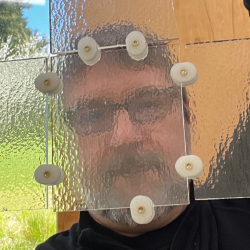
It was great to have such a talented collection of designers working together. Nate was adamant that we not use Phillips head screws for the face of the piece, so we ordered some nice flathead, hex drive screws from McMaster Carr. I’m glad we did!
Hardware Prototype One was made on day two of the residency. 3D Printed hardware with brass heat-set inserts, screws, and flat bullseye glass.
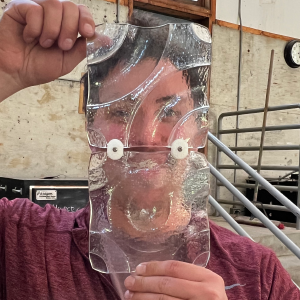
Glass
Meanwhile, the Glass team was firing glass. This was our first time slumping float glass. Our research indicated that we needed to be concerned with the tin on one side of the glass - that it would alter the way the glass interacted with the atmosphere at temperature. Perhaps it would cause Tin bloom, or perhaps it would prevent devitrification. We learned how to identify the tin side by dropping water on the surface.
You may wonder where the tin came from? Industrial sheet glass is produced by floating molten glass on a pool of hot tin. Watch this video for more details.
The first slump test was out of the kiln on day 2:
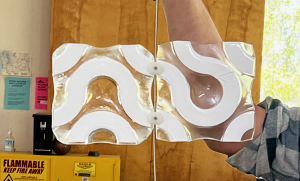
We knew we wanted the pattern to be prominent in our piece. One early prototype used white vinyl stickers to achieve that effect. It worked. It was too much.
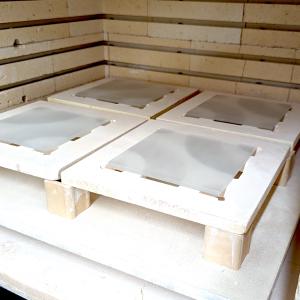
We experimented with a borax solution to prevent devitrification. We experimented with sandblasting the surface to get rid of the tin. One unexpected consequence of the sandblasting process is the variation in the pattern. The sandblasted surface was maintained in the kiln wherever the glass touched the mold, but was fire-polished out everywhere else. We loved this effect and decided on this look for the final production.
Assembly
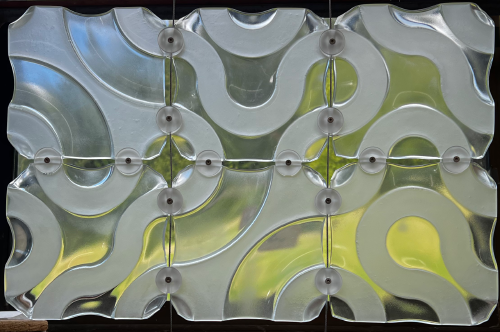
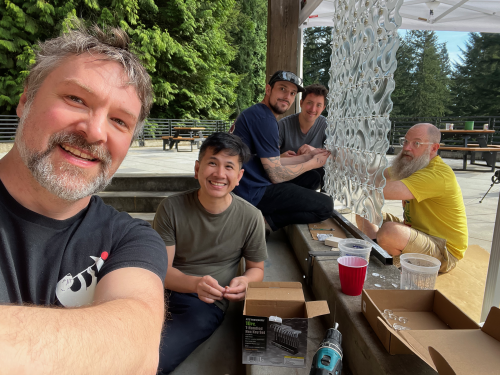
The Fellowship
The Pilchuck website describes the fellowship this way:
Named for Pilchuck co-founder John H. Hauberg (1916–2002)—philanthropist, art collector, and important patron of artists—the fellowship was established to encourage collaboration among a group of outstanding artists.
Groups of up to six members are invited to submit an application to utilize the Pilchuck studios and campus environment for research and development of artwork based on a common theme or a collaborative project.
Group members provide technical support for each other in the exploration of new working methods and engage in critical dialogue. Visual artists in all media as well as writers, poets, art critics, and curators are encouraged to apply; however, if proposing to use glassmaking equipment, some members of the group must have previous experience with Pilchuck’s facilities, as limited technical assistance is available.
Open studio space and access to Pilchuck’s Mold & Kiln Shop, Cold Shop, Print Shop, and Wood & Metals Shop is provided. During this time, Pilchuck’s hot glass facilities are being used for spring residencies, and therefore no hot glassworking is available. Hauberg Fellows are provided living accommodations, meals, travel reimbursement, and a $1,000 honoraria for each group member. Plus, an $500 materials reimbursement for the group.
